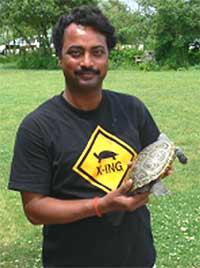|
 |


Rajeev Chauhan
with diamondback terrapin
 |
|
An Asian Scholar Experience

By Rajeev Chauhan
My home is in a very small city, Etawah, in the state of Uttar Pradesh, India. Etawah is an ancient city rich in history. It is situated on the bank of the Yamuna River and the Chambal River, which forms the boundary between the states of Uttar Pradesh and Madhya Pradesh. The ravines of the Yamuna and Chambal Rivers were once a very good place for freedom fighters and now they provide shelter to many gangs of robbers who kidnap children and other people for ransom. So everybody is scared of the ravines and no one wants to go there. Thatís why all the ravines are areas of rich biodiversity. There has been little human disturbance of wildlife. During the 1980ís, some researchers initiated successful conservation programs for crocodiles, which were then on the verge of extinction. Since then the Indian crocodile population has made a significant recovery. Due to its rich biodiversity, the Chambal River was declared a National Sanctuary for the conservation of freshwater turtles, crocodiles, birds and the blind dolphins.
But now the situation is very bad. As police pursue the bandits, human interference increases in the sanctuary and on other nearby rivers. In addition, uncontrolled fishing and poaching have increased, resulting in the death of many turtles and an overall rapid decline in their populations.
The increasing threats to the local turtle populations encouraged me to start looking for scholarship programs that would help to develop my skills and expertise in turtle conservation. My search led me to the Asian Scholarship Program at the Wetlands Institute. The program provided me the opportunity to travel around the U.S., participating in other turtle research. On April 23rd, I arrived at Dr. Peter Pritchardís Chelonian Research Institute in central Florida. There I reconstructed turtle shells of many species with glue and wires. A week later, I joined Tom Mohrman in southern Mississippi, where we studied the reptiles and amphibians on coastal barrier beach islands. Afterwards, I visited the Tennessee Aquarium in Chattanooga, where I spent time capturing turtles from the Tennessee River with Dr. Thomas Wilson. One of my proudest moments was handling a big common snapping turtle.
On May 23rd, I finally arrived at the Wetlands Institute and was greeted by Dr. Wood. I was so pleased to finally meet him. He told me that we would start fencing tomorrow. I did not know about fencing, so he explained to me that the previous year approximately one mile of barrier fencing had been put up on Stone Harbor Boulevard to keep terrapins away from the road during the nesting season. The results were very good in 2005. Terrapin roadkills were greatly reduced.
In a short time, I experienced so many wonderful events once the terrapin-nesting season began. We conducted turtle patrols five times a day, in order to get live terrapins off the roads, to rescue injured terrapins, and to document roadkills. That was beyond my experience; I was never involved in a similar activity before. Terrapins were everywhere. They were trying to find some suitable nesting place on the roads, or in house gardens and back yards. Most of the local people in southern New Jersey were giving the same kind of attention to turtles and their conservation, as we in India pay attention to lions, tigers and elephants. Some people stopped their cars and rescued terrapins from the road. It was a wonderful event for me. In India, not many people worry about wild animals. During the peak of the nesting season, I heard so many phone calls for the Wetlands Institute about either injured terrapins being dropped off or that researchers needed to go pick up an injured terrapin. If the turtle is not too badly damaged, we send it to Dr. Mark Logan, our veterinarian, for treatment. If a terrapin is badly injured, it must be euthanized. We also retrieved undamaged eggs from the road-killed terrapins for incubation.
I was very surprised one day when a lady brought an injured terrapin in a carton and left it on the lab table. When Dr. wood arrived in the lab I asked him what I should do with this injured terrapin. He checked the terrapin and replied to me that we can send it to our veterinarian, who provides treatment to all injured terrapins voluntarily. I was thinking “Wow, how great people are who make all possible efforts to save diamondback terrapins.”
I was surprised by how people are so aware of terrapins. After I spent two months at the Wetlands Institute, I began to understand. It was not a one-day effort. An enthusiastic team of Wetlands Institute volunteers (mostly college and university students) under the leadership of Dr. Wood spends a lot of effort to educate and sensitize everyone. This is accomplished several activities such as the daily turtle patrols during the nesting season, terrapin displays at festivals, the Wetlands Instituteís permanent terrapin exhibit, head starting hatchlings, and terrapin releases with kids. I salute those people who provide help for terrapin conservation. I am also grateful to Mr. William Espenshade III who provided me this opportunity to work with these great people.
|